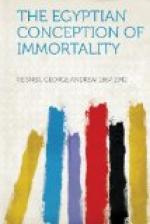I. INTRODUCTION
Of the nations which have contributed to the direct stream of civilization, Egypt and Mesopotamia are at present believed to be the oldest. The chronological dispute as to the relative antiquity of the two countries is of minor importance; for while in Babylonia the historical material is almost entirely inscriptional, in Egypt we know the handicrafts, the weapons, the arts, and, to a certain extent, the religious beliefs of the race up to a period when it was just emerging from the Stone Age. In a word, Egypt presents the most ancient race whose manner of life is known to man. From the beginning of its history—that is, from about 4500 B.C.—we can trace the development of a religion one of whose most prominent elements was a promise of a life after death. It was still a great religion when the Christian doctrine of immortality was enunciated. In the early centuries of the Christian era, it seemed almost possible that the worship of Osiris and Isis might become the religion of the classical world; and the last stand made by civilized paganism against Christianity was in the temple of Isis at Philae in the sixth century after Christ.
It is clear that a religion of such duration must have offered some of those consolations to man that have marked all great religions, chief of which is the faith in a spirit, in something that preserves the personality of the man and does not perish with the body. This faith was, in fact, one of the chief elements in the Egyptian religion—the element best known to us through the endless cemeteries which fill the desert from one end of Egypt to the other, and through the funerary inscriptions.
It is necessary, however, to correct the prevailing impression that religion played the greatest part in Egyptian life or even a greater part than it does in Moslem Egypt. The mistaken belief that death and the well-being of the dead overshadowed the existence of the living, is due to the fact that the physical character of the country has preserved for us the cemeteries and the funerary temples better than all the other monuments. The narrow strip of fat black land along the Nile produces generally its three crops a year. It is much too valuable to use as a cemetery. But more than that, it is subject to periodic saturation with water during the inundation, and is, therefore, unsuitable for the burials of a nation which wished to preserve the contents of the graves. On the other hand, the desert, which bounds this fertile strip so closely that a dozen steps will usually carry one from the black land to the gray,—the desert offers a dry preserving soil with absolutely no value to the living. Thus all the funerary monuments were erected on the desert, and except where intentionally destroyed they are preserved to the present day. The palaces, the towns, the farms, and many of the great temples which were erected on the black soil, have been pulled down for building material or buried deep under the steadily rising deposits of the Nile. The tombs of six thousand years of dead have accumulated on the desert edge.




